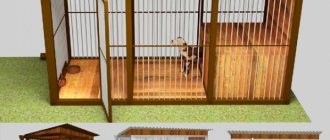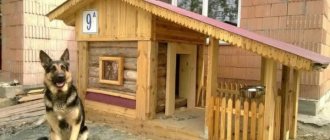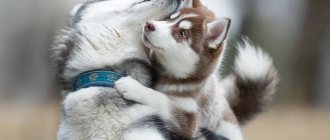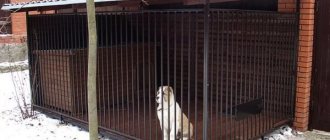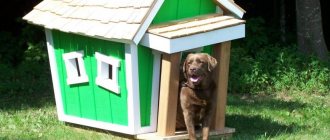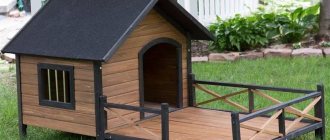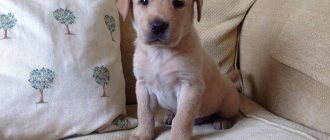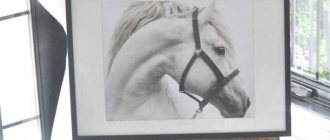Home / Feeding / Is the Jagd Terrier afraid of the cold?
At the beginning of my article, I cannot help but express my gratitude to the people who bred the Jagdterrier breed. I believe that this breed is the standard of a dog’s developed hunting instinct. In any case, I have never seen a jagda not working. No one! They can be overly excitable, the style of work varies among many, but I have never seen a Jagdterrier not work.
The Jagdterrier does not require such training as a hound, such grooming as a husky. You just need to raise a strong puppy under normal conditions for up to 7–8 months. Often the berries begin to work from the very first time they enter the field. To be fair, it should be noted that in other breeds of hunting dogs there are individuals who start working early, but there are much fewer of them. The only drawback of Jagdterriers is their coat: they freeze in winter in some regions of our country, but they were bred for hunting in Germany. I wish we could breed a similar breed, but warmly “dressed”! Now let me get back to the topic: One day my Jagdterrier went into a hole and didn’t come back out. Raccoons lived in the hole. I didn’t believe in the tales that they could dig it up, because I once devoted a lot of time to burrow hunting and knew them well. The raccoon couldn’t strangle the dog either, it’s not the same animal, although it can cause significant injuries to the dog. So, one day a raccoon made the cheeks of our Jagdterrier Chok look like a sieve: a narrow hole passed through a gap in the roots of a huge spruce, and behind the roots a raccoon met a male trying to squeeze through. The cause of death, both for dogs and animals, is sometimes the collapse of holes. I had to witness such events. Once there was even a case when a young hunter fell asleep. He was hunting alone and poked his head into the holes to help the dog, and he was covered with a layer of earth. A badger can strangle a dog, but not a raccoon. An incident during a winter fox hunt, two years after the death of the dog, helped clarify the situation. And it was like this.
In winter, deep, loose snow fell, and hunting foxes with hounds was bad: the dog could not find them at that time. The foxes went out at night to feed, made a circle and entered the holes again. My brothers and I went to the burrows with the Jagdterrier Kesha. His age was 7 months and 2 weeks, and this was the young male’s first time going hunting in holes. We chose small holes, but the foxes visited them every day. That day was no exception: the holes were not empty. Released from his backpack, Kesha furiously scratched into the hole, but could not get there - there was ice at the entrance. I didn’t want to make noise, but there was nothing to do: I had to help the dog with an ax. Having gone 70 centimeters deep, Kesha again began to furiously scrape the ground: apparently, water had flowed in there and frozen. We couldn't help him; we could only rely on the dog. And Kesha did not disappoint: after 40 minutes we heard a furious fight between a dog and an animal.
The holes where the hunting took place were located on a high, clear mountain half-slope. If the fox gets out, she has little chance of staying alive: three shooters in an open field - you have to try hard to miss. After a short period of time, a red nose appeared from the hole, which just as quickly disappeared. We thought that the fox had broken away from the young dog and was now carefully leaving, but, noticing how we raised our guns, she went back. There was no trust in the young dog yet: you never know what to expect from it on its first hunts. So we didn’t expect much agility from the young puppy.
Meanwhile, a fight was going on near the entrance. At first Kesha barked, then his voice fell silent and a knock was heard. And soon the knocking stopped. There was silence. Neither the fox nor the dog came out of the hole. We waited. Suddenly Kesha began to whine, somehow alarmingly. Having definitely listened to the place where the dog’s voice came from, we began to dig a hole. The ground was frozen, things were not going as quickly as we would have liked. Finally the hole was opened, but the dogs were not found there. And silence. What the hell is this?! Here Kesha whined again, and even more alarmingly, but already three meters further away. I had to hit the pit again so the dog wouldn’t die! And then we will fill up the holes, although they are so small that in the spring, when the sweet clover melts, they almost always crumble. And the collective farm cows that graze here in the summer also contribute to their shedding. Despite this, foxes dig up their holes again and again, and so on from year to year. The place for burrows is very good: there are two fish hatcheries nearby, a nesting site for seagulls nearby, plus a stream located literally 50 meters away. Everything is there: drink and food. But I digress.
We made a second hole, but again we didn’t have time: the dog was not here. What happened? We realized this only when we drilled the third hole. It turned out that the fox hesitated on the way out, running into a pile of earth that the dog had scooped up when he entered the hole. Kesha grabbed the beauty by the “waist” and broke her spine. There was a jaw-to-mouth fight (the fox's lower jaw was broken). Further, it was not difficult for Kesha to crush the helpless fox (obviously, then the knock was heard). And then he dragged her, but in the opposite direction from the exit. When we opened the third pit, a picture appeared before our eyes: in a dead end, like two wedges driven towards each other, lay a fox and Kesha on top of it. And even higher was a roof made of frozen clay. Obviously, the dog, having hit a dead end, tried to squeeze on top of the fox and jammed itself.
The redhead was pulled out from under Kesha like a cork from a bottle of champagne - undoubtedly, without our help the Jagdterrier would have suffered a painful death. Both we and he were lucky: the holes were shallow. Apparently, in the previous case, something similar happened with the Jagdterrier, only there the holes were not tapped. These are the situations that can happen when hunting with burrowing dogs. I will be very glad if with my story I help someone save their pet. Good luck everyone!
At the beginning of my article, I cannot help but express my gratitude to the people who bred the Jagdterrier breed. I believe that this breed is the standard of a dog’s developed hunting instinct. In any case, I have never seen a jagda not working. No one! They can be overly excitable, the style of work varies among many, but I have never seen a Jagdterrier not work.
History of the breed
At the beginning of the 20th century, numerous representatives of terriers were bred to participate in the show. Their appearance was brought to perfection, but their performance qualities were muted. Most terriers were no longer able to hunt.
Immediately after the end of the First World War in Germany, German breeders Walter Zangenberg, Rudolf Fries and Karl-Erich Grunewald began to develop a new variety of terriers, entirely focused on hunting.
The work began with four small fox terriers received from the director of the zoo in Munich. The puppies did not fall under the breed standard because of their black and tan color. But Zangenberg was least concerned about color. He was not going to work on the exterior, the task was different - to get maximum hunting instincts.
The defective representatives of the breed were crossed with black fox terriers, which were chosen because of their aggressiveness and persistent pursuit of the animal. The offspring demonstrated hunting qualities and became black in color. The first specialized club of the new breed opened in 1926, and in 1927 club dogs already took part in the exhibition.
The pragmatic Germans called the new breed “Jagdterrier” - “hunting terrier”.
For the health of the offspring, distant relatives were allowed to crossbreed. Welsh Terriers and Old English Terriers took part in the development of Jagd Terriers.
The Second World War forced breeders to stop working on the breed, and the number of its representatives greatly decreased. After the war, already in the GDR, the selection of Jagd Terriers continued.
GDR breeders again increased their livestock through closely related ties. The number of Jagdterriers increased sharply, but among them there were a lot of sick animals.
In 1954, Jagd Terriers were recognized by the International Canine Federation. They tried to breed dogs in the New World, but the Americans showed no interest in the small, nimble hunters.
The German Jagd Terrier dog appeared in our country in the 1970s. Despite the fairly high quality of domestic representatives of the breed, many hunting enthusiasts prefer to buy Jagd Terriers in Europe.
Insulating the kennel with polyurethane foam
This material does not pose a risk to human or pet health and is resistant to moisture. It is one of the best thermal insulation agents. It has an affordable price. It is attached to the inner surface of the booth. Typically elastic polyurethane foam is used. This is due to the openness of its structure and increased moisture absorption. Therefore, it is not used outside.
Polyurethane foam with a rigid structure is suitable for fastening to the outside of the kennel. In principle, this is the best solution when protecting a doghouse from the cold. The material is non-toxic, as it is based on plastic. It can be purchased in both liquid and solid form. The liquid material is applied by spraying, and the solid material is in the form of slabs.
The slabs are large in size and are not suitable for insulating a doghouse. We advise you to resort to using the liquid type, the main advantages of which include:
- filling all cracks and gaps;
- protecting the kennel from mold and rot;
- providing noise insulation;
- long service life (over 30 years).
Characteristics and description of the breed
An adult Jagdterrier is a strongly built, hardy hunter, without pretensions to grace. He has no attractive fur, no funny face, no grace. But the determination and passion of pursuit are beyond praise.
Breed standard, description
The German Jagd Terrier is a medium-sized dog with a powerful build. What it should look like is described in the breed standard.
- Height at the withers : dimensions from 33 to 40 centimeters, does not depend on the gender of the dog.
- Weight : males - from 9 to 10 kilograms, females - from 7.5 to 8.5 kilograms.
- Head : slightly elongated, flattened, with prominent cheekbones and a noticeable chin, a large distance between the ears. The muzzle is not particularly pointed.
- Eyes : small, oval, set far apart.
- Ears : set high, medium in size, triangular in shape.
- Nose : small, usually black. Brown earlobes are allowed in dogs with brown coats.
- Jaws : massive, with a scissor bite, black, dense lips.
- Neck : strong, medium length.
- Body : quite compact, chest circumference 10-12 centimeters greater than the height at the withers. The back is straight, with a strong lower back.
- Chest : deep, ribs arched, laid back.
- Belly : slightly tucked, with a graceful curve.
- Limbs : Parallel, with strong bones and pronounced, lean muscles. The shoulder blades are oblique, elongated, the elbows are pressed to the body, without turning to the sides. Hips – elongated, wide, hock joints – strong, powerful. The paws are round-oval, with powerful, hard, black pads. The front legs are larger than the hind legs.
- Tail : long, straight or saber-shaped. In Russia, the tails of Jagdterriers are docked to a third of their length. The last vertebra is not inclined towards the back. A hunter can pull a carried away dog out of a hole by the tail.
Colors and coat
Jagdterriers have two types of coat:
- hard – rough and thick, forms a beard and feathering, giving a wire-haired dog a disheveled appearance;
- smooth – close to the body, thick, with a thick undercoat.
Both types of coat protect the Jagdterrier from rain, snow, and frost. Dogs are perfectly suited for working outdoors. Dirt and moisture are not retained, and the lint on the belly and thighs protects against parasites.
It is allowed to cross wire-haired and smooth-haired Jagdterriers with each other.
The color of Jagdterriers can also be of two types:
- black and tan;
- black and tan with graying.
Tan - red or yellow. There may be white markings on the chest and paws, the mask on the face is lighter or darker than the main background.
Setting up an enclosure
The enclosure for playing and warming up the Jagdterrier must have an area of at least 10 square meters and be fenced with a chain-link mesh or steel rods. If the dog likes to make tunnels, then the walls of the enclosure must be installed on the foundation. The floor of the space for dog play should be plank or gravel or, as an option, lawn. To help your dog quench his thirst for digging holes, set up a box of sand for him. Under no circumstances should you place your pet’s girlfriend in the enclosure in winter, otherwise this may lead to a brutal fight or the death of one of the animals.
Character and habits of German Jagd Terriers
The Jagdterrier dog was created for hunting, and will never become an obedient lap dog.
The Jagdterrier is not a pet, but a passionate, cruel hunter.
The first thing you should pay attention to is that the Jagdterrier does not share loyalty among everyone; he chooses a leader whom he will obey. Usually this is the person with whom the representative of the breed goes hunting. The remaining family members fall into the category of “forced neighbors.” The Jagdterrier will not obey and carry out commands given by someone other than the leader.
Representatives of the breed are ready to follow commands, but will not fawn or ask for attention. Petting and scratching are not for them. Stubborn and aggressive dogs do not react in the best way to guests and strangers. Through education and training, aggression towards people can be removed, but this will not add friendliness to a born hunter.
Any animal is prey.
The Jagdterrier regards any animal as prey. Birds, cats, rodents, and other representatives of fauna - all fit this definition. In rural areas, representatives of the breed furiously attack hedgehogs, not paying attention to the thorns. Jagdterriers have a high pain threshold, so injuries and wounds go unnoticed and do not prevent the dog from achieving victory.
The Jagdterrier does not like dogs, this is his peculiarity.
The larger the size of the dog you meet, the more the Jagdterrier dislikes it. Reckless boldness, aggression and irritability can lead to an attack by a dog 2-3 times its size. And, surprisingly, to victory in the fight.
You can forget about other animals at home: they have no chance of surviving in the same room as a hunting enthusiast.
Representatives of this breed can only be walked on a leash. The dog unquestioningly obeys only the leader-hunter, and is always ready to start a conflict.
Pros and cons of the breed
The character of German Jagdterriers is complex, built on hunting instincts. This breed is quite difficult to handle.
Pros:
- An excellent hunter.
- Suitable for apartment living.
- Unpretentious to conditions and care.
- Excellent health.
Minuses:
- Aggression and conflict.
- Having entered the fray, he hears nothing.
- Disobedience and stubbornness.
- Frequent deaths during hunting.
- Does not tolerate other animals.
- Not suitable for inexperienced dog owners.
Attitude towards children
The Jagdterrier will not caress or play. This does not coincide with his interests. The most that children can count on is the indifferent and friendly attitude of the hunter. He will agree to run and play from time to time. It is important to teach children the correct attitude towards a dog:
- Do not distract the Jagdterrier while sleeping and feeding.
- Avoid close physical contact with the dog.
- Avoid aggressive games with a representative of the breed.
- Do not stroke or scratch if the dog does not want it.
Compliance with simple rules guarantees the absence of conflicts between the dog and children.
What to feed?
On the one hand, the Jagdterrier is unpretentious in everything, including food, on the other hand, a hunting dog must always be in shape and in full combat readiness, and therefore the owner himself is interested in feeding his pet with the highest quality possible. As is the case with representatives of any other breeds, you can create an animal’s diet from both factory-made dry food and independently selected products.
With dry food everything is clear - the recommendations are the same for all dogs. The higher the class of the product, the better, and although premium and super-premium cost a lot of money, it’s not worth saving on the health of a dog risking its life in a fight with wild animals. Experts point out that certified products are not only completely safe for the pet’s body, but also contain all the necessary vitamins and minerals. At the same time, dry food contains practically no water, which means that for its complete absorption the animal must have constant access to drinking water.
If you decide to refuse the services of factory manufacturers and are ready to create your own diet for your dog, please note that all products must be fresh. You should not give your dog yesterday's food - be prepared to cook it again every time.
The list of permitted and required ingredients must include the following products.
Meat. This component is fundamentally important for any predator, and doubly important for the Jagdterrier, because these are proteins responsible for building muscle mass. It is meat that makes the dog strong and capable of defeating any enemy in close combat. At the same time, the dog’s digestive system is not always ready to digest excessively fatty foods, which is why pork or lamb is undesirable. It is better to focus on chicken, beef and turkey.
As is the case with the vast majority of breeds, it is forbidden to feed the Jagdterrier food from the human table - the dog’s digestive system is structured fundamentally differently and cannot cope with such a challenge. Sweet, hot, spicy and fatty foods, as well as smoked meats and baked goods, will be completely unnecessary on her menu. By feeding your pet such unsuitable foods, you risk being left without a faithful hunting assistant for a day or two.
The feeding regimen of an animal depends on what stage of life it is at. So, babies consume very little food at a time, however, they need to be fed at least four times a day. In most cases, two meals a day will be enough for an adult, but exceptions should be made for pregnant and lactating bitches - their body requires an increased amount of energy and nutrients, so three meals a day are provided for them. In the latter case, experts also recommend introducing tableted vitamins, which are sold at any veterinary pharmacy, into the menu as a separate item.
Like many other dog breeds, Jagdterriers do not understand when to stop eating - the predator cannot be sure that the next prey will be soon, so it eats to its fullest while there is such an opportunity. In the wild, this would hardly harm the dog, but when kept at home, an enthusiastic owner can easily feed the pet into a fat and clumsy carcass, which will no longer be of any use during the hunt.
You usually have to calculate the dosage of food by eye, but keep in mind that in winter, individuals who permanently live in open enclosures need to increase portions - they can only fight the cold with additional calories. Experienced dog breeders indicate that if there is clean snow, it is better to give it instead of water.
Care and maintenance
Living conditions are not particularly important for the Jagdterrier - at home, outside in winter in an insulated enclosure, in an apartment: they are ready for any conditions. But there is still one limitation in keeping a Jagdterrier: the hunter needs hunting and physical activity.
The Jagdterrier cannot be kept on a chain: restriction of activity leads to psychological trauma, the dog becomes aggressive and uncontrollable.
What to feed a Jagdterrier
Everything that the owner gave goes “into the furnace” of the Jagdterrier. The dog doesn’t really look at the contents of the bowl: it smells edible, and that’s okay. The hunting breed requires a lot of calories and fat, so the diet is prepared accordingly.
You can also feed your Jagdterrier dry food – no less than premium food. The dog will not object, and such food maintains a balance of substances necessary for health.
The natural diet of the breed requires calories. Jagdterrier puppies are given both boiled eggs and fresh milk, but adults can do without such excesses. The diet of an adult Jagdterrier includes:
- stringy meat;
- offal;
- buckwheat, oatmeal, rice, millet cereals;
- fish fillet;
- fermented milk products with reduced fat content;
- vegetables;
- rendered beef or fish oil.
The main dish of the Jagdterrier: cereal porridge with meat, offal, and vegetables. It is advisable to grate all ingredients, except meat and cereals, so that the dog does not choose the most delicious one.
Both flat bones and cartilage will be useful for Jagdterriers. They help remove plaque from your dog's teeth and provide the body with the collagen it needs.
Prohibited for use:
- veal;
- semolina;
- River fish;
- pork;
- legumes;
- flour and sweet;
- salted and smoked.
When feeding your dog naturally, you cannot neglect the complexes of vitamins and minerals. It is better to discuss the specific course with your veterinarian after examination.
The frequency of feeding varies depending on the age of the Jagd Terrier:
- up to 2.5 months – 5 times a day;
- from 2.5 to 4 months – 4 times a day;
- from 4 to 8 months – 3 times a day;
- further - 2 times a day.
Walk
Jagdterriers need long walks - at least three hours a day. Activity is essential to maintain your dog's health and nervous system.
The dog will be happy to overcome obstacles, run, and jump. But where other people or animals may meet, you cannot let the Jagdterrier off the leash: he may react negatively to a person, get into a fight with a dog, or start hunting for other animals.
Grooming
The Jagdterrier is not demanding of care: it does not need professional groomers. There are differences in caring for animals with smooth and hard hair:
- For smooth-haired dogs of this breed, a rubber mitten or brush is enough to get rid of dead hair and massage the skin - twice a week is enough. During the shedding period, you will have to brush it daily.
- Wire-haired Jagdterriers require more attention: working dogs are trimmed, hygienically trimmed under the tail and between the toes, and the beard is shortened. The standard prohibits both trimming and cutting the Jagdterrier, but this only applies to show animals.
Hygiene
Jagdterriers do not really need water treatments - they are washed only when necessary, using shampoo for the desired coat type. The dog itself will not miss the opportunity to plunge into an open body of water, but you will have to make sure that no one is in the bathing area.
The Jagdterrier's eyes need to be cleaned every two weeks - with a cotton swab with chamomile infusion or drinking tea.
The ears of these dogs will have to be examined once a week, and cleaned as necessary, using a cotton swab with a special lotion.
The claws of representatives of the breed are trimmed once a month. The fifth toes on the front paws require attention - they are shorter than the others, and the claws do not grind down on their own.
A dog that takes part in hunting needs treatment for parasites and insects.
Comfort and beauty for cheap: do-it-yourself dog house
Dogs also need housing, especially in winter!
You can build a good dog house in one day. Materials for this structure can be found on any construction market. By building a high-quality, beautiful home for your four-legged pet, you can make your dog’s stay outside comfortable in any weather. In addition, the building will decorate the local area.
In this article we will figure out how to make a booth, how to insulate a kennel for a large street dog for the winter, and how to decorate a dog’s house! So, we build ourselves, to our conscience and to the envy of our enemies!
Training and coaching dogs
Socialization of Jagdterriers is extremely necessary. Dogs of this breed that are prone to aggression must learn to react correctly to surrounding living beings, the home environment, and natural phenomena. The sooner socialization of the dog begins, the better.
Jagdterriers also need to be trained as early as possible. Representatives of the breed are reluctant to carry out commands that are not related to hunting, are stubborn, and do not recognize rules and restrictions.
The owner of a small Jagdterrier must show consistency, perseverance and unquestionable authority in order to teach the dog the things necessary for living together.
It’s worth paying attention: Jagdterrier puppies tend to try everything – this is one of the ways to get to know the world.
You will have to learn to distinguish such bites from real aggression. In response to aggression, you must immediately demonstrate a negative reaction: scream loudly and walk away from the puppy.
He will understand that he did wrong and will try not to repeat the mistake. The aggression of a representative of the breed must be brought under control as early as possible - in an adult dog it will no longer be possible to correct the behavior. If you can’t cope on your own, it’s better to contact a dog handler.
At six months, hunting skills training for burrow hunting begins. At the same time, the grown-up puppy begins to try to question the owner’s leadership and gropes for the limits of what is permissible.
It is best to train a Jagdterrier on an animal from 8 months to one and a half years: at this age, representatives of the breed quickly learn and act consciously.
The most common training equipment for these purposes is a hole made of boards or bricks. They put the dog there. If she rushes there in search of game without waiting for a command, it means she is a born hunter. After training in the hole, the Jagdterrier is introduced to future victims: foxes or raccoons sitting in cages. A representative of the breed must show aggression. After this, the animal is released into the hole, and then the dog is released.
Jagdterriers, which are planned to be actively used in hunting, will have to be “introduced” to all types of game that they will hunt. The natural aggression of a hunting dog is encouraged and further provoked.
If you do not plan to use the Jagdterrier as a hunter, you can train it yourself. But if you have problems with aggression or disobedience of the dog, it is better to contact a dog handler.
Features of behavior
As befits a real hunter, the Jagdterrier is distinguished by exceptional energy. This is a dog who never sits still. And if the energy is not directed in a peaceful direction, the child begins to look for things to do on his own - chewing furniture, digging holes, chasing cats. It is absolutely not suitable for lazy and melancholy people, but in hunting or sports the breed has no equal.
To this day, the Jagdterrier has retained amazing working qualities. This dog has an excellent sense of smell, endurance and a desire to work, thanks to which the breed is gradually moving from a burrow hunter into the category of universal hunters. Yagi are capable of hunting small burrow predators, swamp and steppe game, and ungulates with equal success.
The German Hunting Terrier cannot be called a dog with high communication skills. The breed does not get along well with other animals (especially rodents or birds); due to its innate leadership qualities, the dog can start fights on the street with other dogs. Treats strangers with caution, but without excessive aggression. Although with a good level of early socialization this deficiency can be reduced, it cannot be completely eradicated.
Another feature of the breed is courage, absolute and sometimes reckless. When going out to fight a predator, or defending a dog’s owner, the instinct of self-preservation is completely turned off. Which is fraught with injury, since the Jagdterrier’s opponent’s size never stops him; he is ready to fight to the death with anyone.
The breed is not suitable for novice dog breeders; it has a complex character. During educational processes, a poorly motivated child often displays remarkable stubbornness and self-will. And with harsh correction methods, he may snap back. Hunting breeds that do not know how to show independence in real hunting conditions are doomed to death; in Jagdterriers it is this trait that complicates the educational process.
Advantages
The German Hunting Terrier has a lot of advantages:
- Intelligence and quick reaction;
- Irrepressible energy;
- Strength and endurance;
- Good hunting instinct;
- Excellent hearing and sense of smell;
- Courage;
- Ability to make independent decisions;
- Compact dimensions;
- Easy to care for;
- Good health;
- Good security qualities;
- Unpretentiousness in content.
All the advantages of this little dog cannot be included in one list.
Flaws
Of course, despite all the advantages of the breed, there are also disadvantages:
- Poor level of communication;
- Hyperactivity;
- Lack of self-preservation instinct;
- Difficulty in training;
- Stubbornness;
- Frequent injuries.
Hunting with a German Jagdterrier
In Russia there are enough animals that can be hunted with the help of a Jagdterrier:
- Boar . A dog for boar baiting must be 2 years of age. Baiting involves the use of a pack that surrounds the animal and forces it to freeze in place, giving the hunter the opportunity to take an aimed shot.
- Fox . Jagdterrier catches a fox from a hole. This method of hunting requires silence so that the animal does not use the escape hole. The Jagdterrier's task is to catch the fox without damaging the skin.
- Beaver . The Jagdterrier, on command, tears apart a beaver's lodge, paralyzing the owner of the den with a loud bark. When there is enough space, the dog kicks out the occupant of the house or strangles him on his own.
- Badger . Having found a badger's hole, the Jagdterrier dives in and tries to drive the badger out, under the hunter's shot, while barking about the find. Often a hunter has to pull a buried dog out of the ground.
- Hare . Not the best choice. Having noticed a hare, the Jagdterrier tries to chase it, but the dog does not have enough speed for this.
- Duck . The Jagdterrier loves ponds and reeds. Finding hidden ducks and picking them up is no problem for this dog. But the owner will have to restrain the Jagdterrier so that he does not rush to catch the birds on his own.
A dog of this breed, carried away by a fight or pursuit, does not hear the owner and does not respond to commands. A high pain threshold allows Jagdterriers to fight until complete victory. They just don't feel pain. Often dogs of this breed are seriously injured or killed while hunting.
Assembling the dog house frame
So how do you make a doghouse? Work should begin by creating a foundation. You need to cut 3 bars (5x10 cm) 110 cm long and 2 bars (5x10 cm) 90 cm long. Connect them as shown in the picture, making sure with a carpenter's square that all corners are right, and fasten 10 cm self-tapping screws (two at each joint).
Assembling the frame for the booth floor.
Next, you must cut a rectangular piece of 18 mm plywood measuring 90x120 cm - the floor of the future booth. Attach it to the frame with 5 cm nails or screws every 25 cm.
Fastening the booth floor.
Using 5x5 cm timber, build a frame for the side walls. If you want a rigid structure, install a center post on each side. Once you have assembled the side wall frames, you should attach them to the base with a few 10cm screws. Before fastening, make sure the walls are vertical; for this you will need a spirit level.
Installation of the side wall frame.
Now it’s time for the frames of the front and rear walls. To make them you will need 5x5 cm bars. Secure the manufactured frames with 10 cm screws. As you can see in the picture, the front and back walls are different. You must place two additional posts in the front wall frame. The distance between them is the width of the entrance to the booth. Make sure your dog can easily walk between them.
Installation of the frame of the rear and front walls.
Now you have to build the roof of the booth. For reasons of efficiency, ease of construction and aesthetic appeal, we recommend that you create a roof with a 45º pitch.
Saw off the bars of the required size for the rafters and ridge. Secure the rafters to the frame of the booth with 10 cm screws, first checking their parallelism with each other on each slope. Cut the ends of the rafters at an angle of 45º.
Creating a frame for the roof of the booth.
Making roof frame elements is quite easy. To do this, simply follow our instructions and cut the rafters to the required size. Please remember that all dimensions in the pictures are in inches (1 inch = 2.5 cm). It is necessary to make grooves in the rafters, so that they will better adhere to the walls.
After cutting the first pair of rafters, make sure they fit well into place. If this is not the case, make the necessary adjustments, and after that, using the first pair as a template, make the remaining rafters.
Necessary roof elements.
Health
The German Jagd Terrier is distinguished by enviable health. There are few propensities for genetic diseases:
- displacement of the lens, inherent in all terriers;
- Ehlers-Danlos syndrome – excessive elasticity or laxity of the skin.
How long do Jagdterriers live?
In the absence of serious injuries and infectious diseases, the average life expectancy of a Jagd Terrier is from 12 to 15 years.
Vaccinations
Infectious and viral diseases are dangerous for dogs that spend a lot of time hunting: contact with wild animals and an increased risk of ticks make vaccinations necessary. Jagdterriers are vaccinated against:
- plague;
- rabies;
- piroplasmosis.
Mating
- The female Jagdterrier is ready for mating at the age of 1.5 years, or after the third heat. The maximum duration of estrus is 21 days.
- Males are bred no earlier than 2 years of age.
It is important to avoid close relationships, so you will first have to carefully study the pedigree of your partner dog.
Mating takes place on the dog's territory - there he feels more comfortable.
Jagd terriers take about 63 days from mating to birth. The gestation period depends on the number of puppies in the litter. A female Jagdterrier brings from 2 to 9 puppies.
Where to install?
Make sure the booth will be in a dry place. A dog will never live in a puddle or sleep on a damp floor. If possible, install the booth near the wall of the house or near the fence - this will provide additional protection from drafts and wind.
You shouldn’t place your dog right next to the entrance to a crowded street - the constant presence of strangers makes the dog too nervous, and the owners will get tired of the pet’s constant barking.
The ideal option is to install the booth a little deep in the area, partly under the shade of a tree, so that the dog is comfortable.
The easiest way to build one is from a metal mesh. The enclosure is either connected to the wall of the doghouse, in which there is a hole, or the booth itself is placed inside an already fenced space. It all depends on your imagination and the possibilities of the site.
Cost and choice of puppy
The German Hunting Terrier - Jagdd Terrier - is a fairly common breed of dog, but it is better to take its representatives from specialized kennels where they know how to handle small hunters. Jagdterrier puppies raised by a non-specialist may be more aggressive. What you should pay attention to:
- Males are better suited for hunting. Estrus in females disrupts concentration and reduces attention.
- Jagdterrier puppies often fight among themselves. If the baby avoids the fight, perhaps he is cowardly and unfit for hunting.
- If a dog is chosen for hunting, it is important that the parents are also hunters - anger and persistence are inherited by Jagdterriers.
- You should not take the most aggressive baby: when he grows up, the aggressiveness may become excessive.
- The good character of the small Jagdterrier is evidenced by the lack of fear of strangers, but resistance when trying to turn the puppy onto its back, without squealing or growling.
A club Jagd Terrier puppy, from working parents, with documents, will cost from 15 to 20 thousand rubles.
If exhibition activity is not planned, you can contact hunters who have a dog of this breed. Such a puppy costs around 5-8 thousand rubles.
Is it possible to adopt an adult Jagd Terrier?
Much depends on the previous owner, how he raised and trained a dog of this breed. In any case, you will have to prove the dog’s right to leadership. But it is quite possible that the goals and objectives that the previous owner set for the Jagdterrier will not coincide with the desires and capabilities of the new owner.
You definitely shouldn’t adopt an adult Jagdterrier if there are other animals in the house.
It is not advisable to adopt a dog of this breed as an adult: this is fraught with serious problems.
Jagdterrier or fox terrier
Related dog breeds, however, have a lot of differences:
- Appearance . The Fox Terrier is cute, which cannot be said about the Jagd Terrier.
- Courage . The Jagdterrier is aggressive and fearless; fox terriers are cautious when hunting. This leads to the fact that many Jagdterriers die long before old age.
- Aggression towards people . Fox terriers do not hesitate to bite strangers, and Jagd terriers, although they are wary of strangers, do not use their teeth.
- The watchdog qualities of both breeds are excellent.
- Walking on a leash is essential for both breeds.
When choosing between a Jagdterrier and a fox terrier, you need to understand exactly what you need from a dog and choose based on these criteria.
Tools
Before you start building the structure, you should prepare the necessary tools:
- screwdriver;
- hacksaw;
- hammer;
- marker;
- ruler or tape measure;
- plane - if unplaned material was purchased;
- metal scissors.
Also, before starting work, prepare the material:
- fasteners - screws, nails;
- bars, boards, lining;
- roofing material;
- insulation;
- plywood or chipboard;
- impregnation to protect wood from external influences.
You also need to take care of the thermal insulation material before starting assembly, and choose the best option in terms of environmental friendliness, practicality and affordability.


